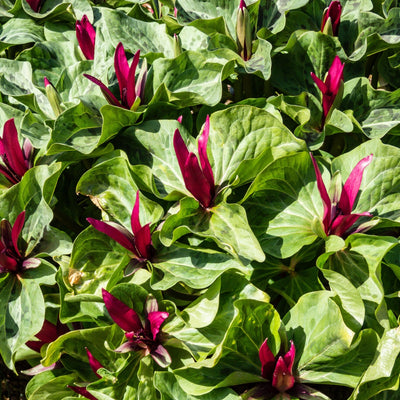If you want a gorgeous flower that adds color to your garden, you might want to plant Yellow Trillium. This Trillium is a pretty flower that is native to the Smoky Mountains area; however, this Trillium has gradually spread to other parts of the United States as well. This flower is a spring ephemeral with a thin stem that can reach up to 18 inches in height. It loves multiple soil types, including sand, loam, and clay. It grows well in moist soil but can grow well in dry conditions, making Trillium easy to take care of. What does Yellow Trillium like to grow with?
Grow Trillium With Multiple Types of Other Flowers
This Trillium grows well in the sun as well as the shade. If left alone, it grows relatively slowly; however, it may grow faster if combined with other flowers in your garden. For example, this Trillium loves to grow with other plants, including Wild Blue Phlox, and Virginia Bluebells. If you combine Yellow Trillium with these flowers, you will have a gorgeous landscape in your garden that is filled with pretty colors. It loves to grow with beautiful spring wildflowers. Furthermore, this Trillium species has a long lifespan and can live up to 25 years.
Yellow Trillium Grows Well Throughout the Year
If you want to see pretty yellow flowers on top of this Trillium as quickly as possible, then planting it early in the fall or early in the Spring is ideal because the soil is still pretty warm. Then, it will bloom once the temperature starts to warm up outside. While Trillium goes dormant during the winter, it can also survive. When the temperature warms up, you'll spot three pretty leaves, silver and green. Then, the yellow blooms start to appear shortly after that. Many people love the fragrance of lemon and oil that radiates from Yellow Trillium.
Sources For Trillium Plants
If you are looking for pretty Trillium, we can help you. At Tennessee Wholesale Nursery, we have the best Trillium around, and we would love to help you complete your home or office garden. Call our flower experts today to view our plant and flower selection!
There are many types of Trillium, and one of the most popular is Prairie Trillium. This beautiful plant has unique leaves that mix dark green and light green. Then, this Trillium species has dark red flowers that emerge from the bud during the Spring and Summer. Also, colorful shoots in the middle create a unique look everyone loves. What should you know about caring for this species of Trillium?
Caring for Your Prairie Trillium Throughout the Year
While this species of Trillium will grow well in sunshine or the shade, you still have to take care of it. To grow your Prairie Trillium, you should:
- Fertilizer: When you plant this species of Trillium, peat moss and compost work well for amending the soil. This Trillium species prefers slightly acidic soil. It is the best growing medium if you have decaying leaves from deciduous trees in the area. In the fall, you can enhance the soil's nutritional content by adding one inch of compost or leaf mulch to the Trillium planting area.
- Pruning and Trimming: Your Trillium plants will naturally want to spread by clumping together and setting seeds. When they start to flower, allow the seeds to form. There is no need to cut or trim the plant.
- Mulching Your Trillium: The best time of year to add mulch is in the fall. One or two inches is enough to give your Trillium enough nutrients. It would be best if you used mulch to give your Trillium room to grow. It is not a plant that enjoys competing with other plants and flowers in your garden.
Following these flower care tips, your Trillium should grow well throughout the year. There is only a little need to water this species of Trillium unless the soil is arid.



